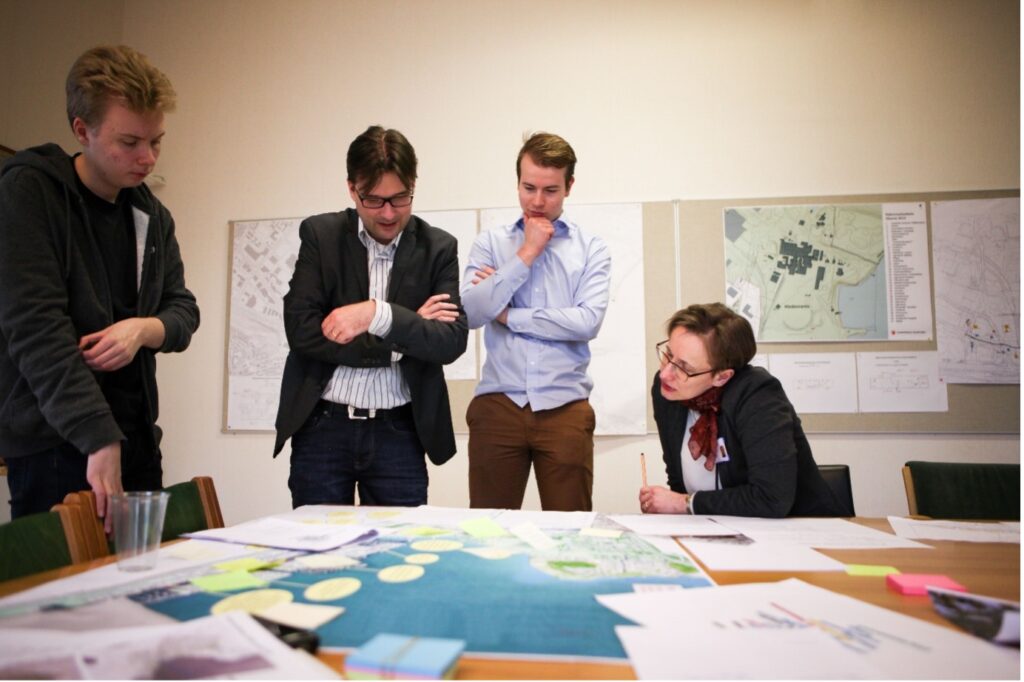3 May 2024
The Power of Co-design: How the Idea of Nordic Superblocks Emerged
Citizen participation in projects such as urban planning and development may feel like an extra burden. The diverse citizens with their urgent needs may be difficult to handle and the interactions demand time. However, if done wisely, citizen participation can pay back well. To encourage everyone to pass their comfort zones, I will share the story of how the idea of Nordic Superblocks emerged, with hints about where to focus to succeed.
The right and early timing
Hiedanranta is an ex-industrial area in Tampere, Finland, that the city bought to develop a new western center with high sustainability goals. For the spatial and conceptual solutions of the district, an international idea competition was organized. As the results were published in spring of 2017, we as a group of urban researchers saw the need to enrich and provoke public discussion around them. There was already an open-minded and collaborative tone in the development of the area, thus it was not a surprise that the city organization jumped straight in as we proposed to organize together a series of participatory workshops. In Finland, law requires possibilities of citizen participation in planning, but not in such an early stage as this was. This means it was an experiment also for the city organization.
The timing for the workshops was right because they brought all different kinds of stakeholders together at once. In the workshops, the future architects from different firms met for the first time the planners, traffic designers, and other city authorities, along with citizens and other local representatives. This means the discussions over the designs were started openly together and their setting was created in public.
Not against but for
The role that citizens are given to participate is often to react to ready-made plans by objecting to something in them. With the workshops in Hiedanranta, our aim was to overcome this role. Citizens do have local knowledge that is worth their weight in gold, they know places and people. They also know their own needs, which are becoming more and more diverse. It becomes very difficult, almost impossible, for a designer to know all the diversifying situations of everyday life . Getting the people involved becomes necessary. However, there are prejudices on all sides.

It takes time to understand the plans that require specific skills to be read. Having a familiar place printed on the same scale on a film and put on the map may help. (Photo: Meri Lampinen)
Designing together
To support the building of trust, our workshops were long and allowed deep conversations in small groups. In each of the groups, there was at least one architect, planner, and researcher with three or more citizens. There was a big map of the plans on the table. Usually, the conversations started with the architect explaining the plans, while others asked questions or pointed out things. Nothing was too fixed yet, meaning there was room for developing the ideas further, as there anyway was a need for combining elements from different plans. Each workshop lasted for three hours and ended with a shared meal. Three of the workshops were organized in sequential evenings. There were altogether 202 participants in the four workshops, out of which 121 were citizens.
What came out?
While designing together, alongside solving defects in the plans, many future assets for the area were recognized (See more: Alatalo et al., 2017) From these, four strong themes emerged. The first of them dealt with the local communities as a starting point, the second brought up the idea of re-thinking collaboration and sharing of resources on a block scale, the third theme worked for lively streetscapes and the fourth tackled the challenge of reusing large vacant factory premises. Here we can already recognize the core of the Nordic Superblocks as we understand them today: a new scale of collaboration on a block level or between several blocks, that allows e.g., to creation of better quality and more versatile shared spaces for residents, and provides tools for lively streetscape and energy communities.
The idea of Superblocks got many stakeholders excited because thinking on this new scale allowed the reorganization of most of the elements present in urban structure. However, advancing such a holistic new approach requires overcoming many barriers in the prevailing system of designing and building cities. The following development of Nordic Superblocks since 2017 has shown us how the early workshops were able to form a citizen-expert coalition that was needed to create new alternatives to the professional modes of practice that are usually dominated by market, creatives, and regulations. (Read more: Sjöblom et al., 2021) This means that it was not only an excellent design idea that emerged from the co-design, but also the push on diverse fronts needed to make it real and built.
Elina Alatalo
Architect, Researcher
PONTE research group
Tampere University
